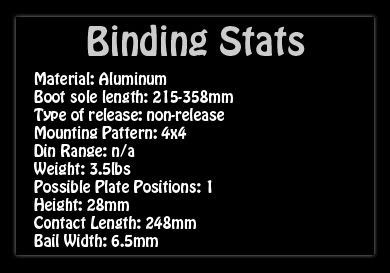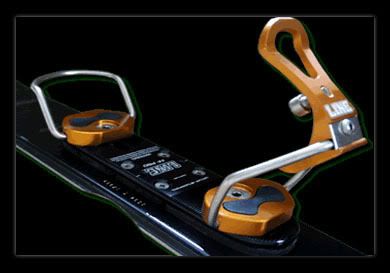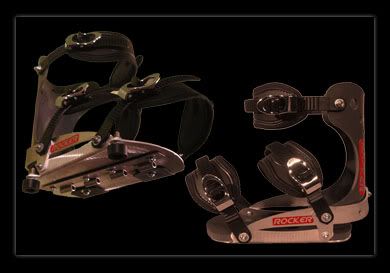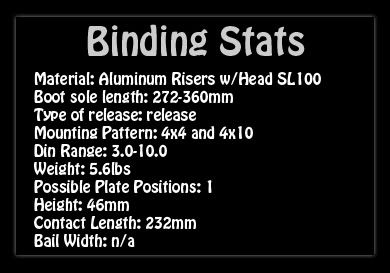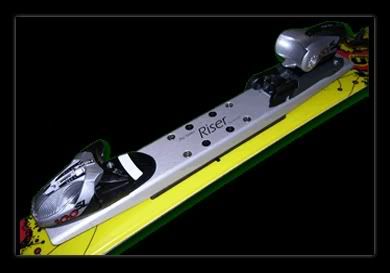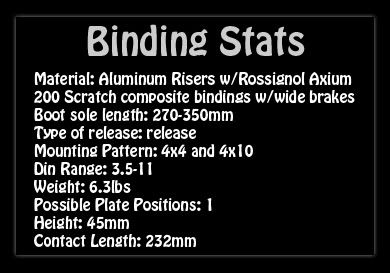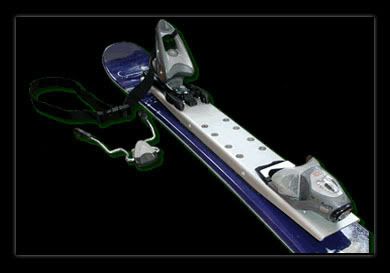Purchased late 1999 along with 2 hard rubber spacers (raising the binding 7.5mm – 2.5mm and 5mm), fitted to a Line Jedi 89cm Skiboard.
This was my first adventure on real skiboards. Previously I had skied big boy’s skis for about 17 years and then had a play on some Salomon Blades for a week or two. However the need to go off piste was a must, so I immediately got a pair of Jedi’s with the FF Pro’s.
Compared to a release binding, on a traditional ski, there was a bit of transition required with regard to the binding…however I am casting my mind back 13 odd years now, but this is what I can remember (FF’s last used 3 years ago although they are now on my spare Lacroix 99 and will be used again next season)
The bindings on a Solomon Blade are basically cheap and crude. Okay for a beginner/intermediate, but anyone wanting to do anything serious would not keep with them, or the actual blades themselves, other than for on-piste convenience.
The setup of the FF’s is easy once you understand the basics of how a binding and boot are designed to work together. Each boot has a mid point (centre) mark (normally small line) on the lower side of the boot. Whilst the binding main plate has a centre line marking.
Initially for setup you should go with the boot directly over the binding centre point, and then go and ski a bit, before trying a few different setting. The FF binding has a fine toothed interlocking base-to-clamp setup, so movement is straightforward. One hexagonal nut at either clamp would release it so it could be moved a few teeth in the direction required. Moving the other clamp proportionally. Make sure it is a firm fit though i.e. when you activate the clamp there is a bit of snap to it actuation as it closes on the boot front.
Finally, once you have decided on your on piste and off piste setup (primarily if on a low floatation Skiboard), you should then mark the positions so you can change quite quickly (about 5 minutes to do all 4 clamps).
One tweak I did was to place a bit of foam under each clamp nut within the rubber spacer to prevent the nut falling off in to the raised (7.5mm) gap. Which if you are up a mountain is a little bit annoying, as you need to take the complete binding off to get the nut back on.
As the FF’s are a fixed binding then there are no brakes so you need to get used to that setup. However, u
sing the ankle strap (release binding brake equivalent!) was a right faff and I soon modified it. Basically getting in to a fixed binding can be awkward particularly depending on gradient, snow conditions and if you are a little under the weather! Normally you are forced to take the skiboards off on bubble lifts etc and when you do a bit a trekking to get to some powder, so you definitely need to have got that sorted before you venture there.
I adjusted my bindings to accommodate this by making sure the heal and toe swing arms had some resistance (slight bend) so they would stay where you placed them – especially needed on the heal side. Then you do not need to use the strap to hold it up…Next I made an adjustment to the standard ankle strap as the clip would get full of compressed snow preventing it’s ease of use. There I changed by modifying the strap – made it one 10 inch single length with a stop at one end – so it could be placed under 2 boot buckles so no strap clips to connect. This meant if the ski did come off – it never did – then the strap was clamped under the buckles and prevent an escaping ski. Other than that a slight boot adjustment to the rear if a lot of off piste was to be undertaken and that was about it.
Also I went away from the little tie cord loop which went around the heel bar clamp, and looped the synthetic material (about 2.5cm (1 inch) width) around the bar and hand sewed it on and then placed a small plastic cable tie through it. The idea there was to provide extra strength and to give the setup some resistance so that the strap did not just fall down. It basically stayed in the position you placed it and hence made it easier to locate and use.
The front clamp is a double swing mechanism and the same idea was used on the upper swing element as it was to the main clamp. Hence, some resistance was introduced in to the smaller clamp so that it did not just flop around. Basically, once again, it would stay where you put it…Which when you are bending over with all your ski gear on, sometimes half way up a mountain, with a wind blowing, it can make things a lot easier.
From what I can recall they were the only mods carried out. They all worked for years making it quicker and easier to get in and out of the FF’s – should work on other fixed binding setups too.
Construction wise the FF’s were faultless. Light, strong and after being tweaked easy enough to get in and out of what ever and where ever.
Basically the FF’s are 13 years old and there is nothing wrong with them – particularly as there is nothing much to go wrong with them. It’s a simple, but effective design. Whilst to break an FF you would need to attack them with a power tool or something.
The double spacers provide a bit of cushioning – I imagine – and lift the FF off the board so the clamp arms/boot are out of the way on high angle carves. So for the little bit of extra cash they cost are worth having – I think 2.5mm was standard and then you could add to that if you wanted.
As a quick comparison to using the FF’s against a release binding (with brakes) on a Skiboard I would say the FF’s have several plus points.
They are a really light binding (max of 700g inc spacer each) in comparison with 2000g each (2Kg) for the release binding, riser & spacer (Tyrolia SP130) especially as the release binding requires a riser plate. So the lightness makes all day skiing effortless – unless you are off piste on low floatation skiboards.
Once setup for “you” then there is basically nothing to worry about. Just clamp yourself in and then that is it. They’re on, and they are not coming off unless you take them off.
Another little nice thing is the rear clamp loops make them easy to carry at the end of the day without dragging on the floor – depends on how tall you are though !
The 4 hexagonal screws fixing them to the board mean that they are easily removed so you can flat-pack you skiboards in your travel bag or rotate the binding if some “damage” has occurred.
Downside(s). Well once tweaked that would be the getting in to them on tricky terrain, but similar problems can be had with the release bindings i.e. compressed snow on bottom of boot issues…With a release binding you can kick/drag your boot over the top of the binding whilst the brakes prevents the ski from liberating itself. However, when there is no brake then you have a free moving ski and you need to build a flat platform first etc – can be tricky when it is steep and deep. Then you have to go for pole pashing/stabbing off the boot base by yourself or a mate. Hey, but you can still have that fun with a release binding just that is is a little bit easier with a braked ski.
Overall the FF’s are faultless and on piste/park I would give them 10/10 especially as they transmit any input directly to the board…7.5/10 unmodified.
Off piste they have fixed binding limitations. If you do not need to take them off then really they would be 10/10, but that is never going to happen. So off piste I would say 8.5/10 (modified) and 7/10 (unmodified)
Presently I ski Custom Summit 110’s (2012) with 5mm rubber spacer, synthetic riser and Tyrolia SP130 release bindings with brakes (downside, quite heavy compared to fixed binding), which I have reviewed elsewhere here. Whilst my big boy’s skis are generally left in the garage! Ski standard Expert when fit!
Rider – Spanners – Expert Skiboarder
